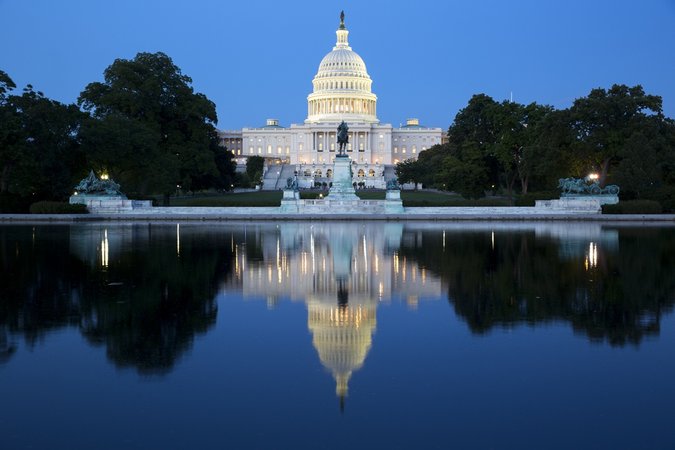Emissions Projections under Alternative Climate Policy Proposals
In this issue brief, RFF researchers estimate the projected energy-related carbon dioxide emissions under different climate policy proposals.
Resources for the Future (RFF) staff utilized a suite of models to estimate the projected energy-related carbon dioxide emissions reductions under different climate policy proposals, including alternative carbon fee scenarios.
- The first scenario includes tax incentives for renewable energy, energy storage, energy efficiency, and clean light-, medium-, and heavy-duty vehicles (similar to the Clean Energy for America Act, CEAA) AND clean electricity targets embodied in grants to retail electricity service entities (similar to the goals embodied in the Clean Electricity Performance Program, CEPP) set at $150/MWh for the first year of operation. [1]
- The second set of scenarios includes the “central case” carbon fee scenario in which an economy-wide fee on emissions is set at $15 per metric ton CO2 beginning in 2023, rising to $30 in 2028, and increasing at $10 per year (above inflation) through 2040. We show results for this scenario for multiple policy cases:
- With and without an exemption for gasoline; and
- With and without an exemption for gasoline in addition to CEAA and CEPP-type programs
- The third scenario is an alternative economy-wide carbon fee that starts at $15 in 2023 and increases 5 percent annually (above inflation), without exemptions and without additional policies.
Details on all major modeling assumptions are included in the RFF Issue Brief “Emissions Projections for a Trio of Federal Climate Policies.” [2]
Figure 1 displays the two price path scenarios. By 2040, under the central case scenario, the carbon fee is $150 (in 2023$) whereas in the alternative carbon fee scenario, the fee is $34 in 2040.
Figure 1. Carbon Price Paths

Figure 2 displays the projection of energy-related carbon dioxide emissions under each of the six policy scenarios through 2040.
Economy-wide energy-related carbon dioxide emissions (from all sources of fuel combustion) under the CEAA/CEPP-only policy are projected to be about 3,700 mmtCO2 in 2030 or about 39 percent below 2005 levels, with most of the reductions (relative to BAU) coming from the power sector (analysis of the CEAA includes energy efficiency incentives, the zero emission vehicle program, and state and federal plug-in vehicle subsidies).
Adding a carbon fee, with or without a gasoline tax exemption, to those policies delivers some additional emissions reductions from fuel switching in the power sector, especially in the first year of the policy, and provides additional incentives for emissions reductions in the industrial, transportation, and buildings sectors, especially in the long run. In 2030, the central case carbon fee with no gasoline exemption, plus the CEAA and CEPP, reduces energy-related carbon dioxide emissions to 52 percent below 2005 levels, which is consistent with the Biden Administration’s Nationally Determined Contribution (NDC) target under the Paris Agreement, and over 13 percentage points more than the CEAA and CEPP alone. [3] Most of these additional emissions reductions come from the industrial and buildings sectors.
For comparison, the US pledged to reduce its emissions by 2030 by 50-52 percent compared to 2005 levels of 6,635 million tonnes CO2e. Energy-related carbon dioxide emissions account for 80 percent of US greenhouse gas emissions, and totaled 5,999 million tonnes in 2005.
Figure 2. Energy-Related Carbon Dioxide Emissions under Alternative Policy Options

The emissions reductions for the central case carbon fee with and without an exemption for gasoline are relatively similar. Under the central case carbon fee policy with CEAA and CEPP policy provisions, emissions are 52 percent below 2005 levels without a gasoline exemption, compared to 50 percent below 2005 levels with the exemption. Without the CEAA and CEPP policy provisions, the economy-wide carbon tax results in emissions 45 percent below 2005 levels without the gasoline exemption and 44 percent below 2005 levels with the exemption. These small differences reflect the fact that historically light-duty emissions have been relatively insensitive to changes in gasoline prices. However, carbon fee revenues are reduced significantly if gasoline is exempted from an economy-wide carbon fee.
The alternative carbon fee that starts at $15 in 2023 and rises at 5 percent annually (above inflation), with no exemptions, is projected to have similar effects on energy-related carbon dioxide emissions as the CEAA/CEPP-only policy, especially in the first decade or so of the policy.
In closing, RFF modeling projects that each of the policy options considered here would result in substantial reductions to energy-related carbon dioxide emissions. A comprehensive set of the policy options considered would fully achieve the US government’s stated climate goals, while other combinations would make significant progress toward their achievement.
Endnotes
1. We assume that gaming of the program is precluded. The modeling of CEPP does not include proposed penalties. Under the CEAA/CEPP-only policy, 78 percent of power is produced by clean sources in 2030, just shy of the CEPP’s goal of 80 percent clean by 2030.
2. The Appendix in the issue brief “Emissions Projections for a Trio of Federal Climate Policies” describes modeling a clean electricity standard (CES). The modeling in this analysis uses the incentives for clean electricity developed in the reconciliation process.
3. For comparison, the US pledged to reduce its emissions by 2030 by 50-52 percent compared to 2005 levels of 6,635 million tonnes CO2e. Energy-related carbon dioxide emissions account for 80 percent of US greenhouse gas emissions, and totaled 5,999 million tonnes in 2005.









